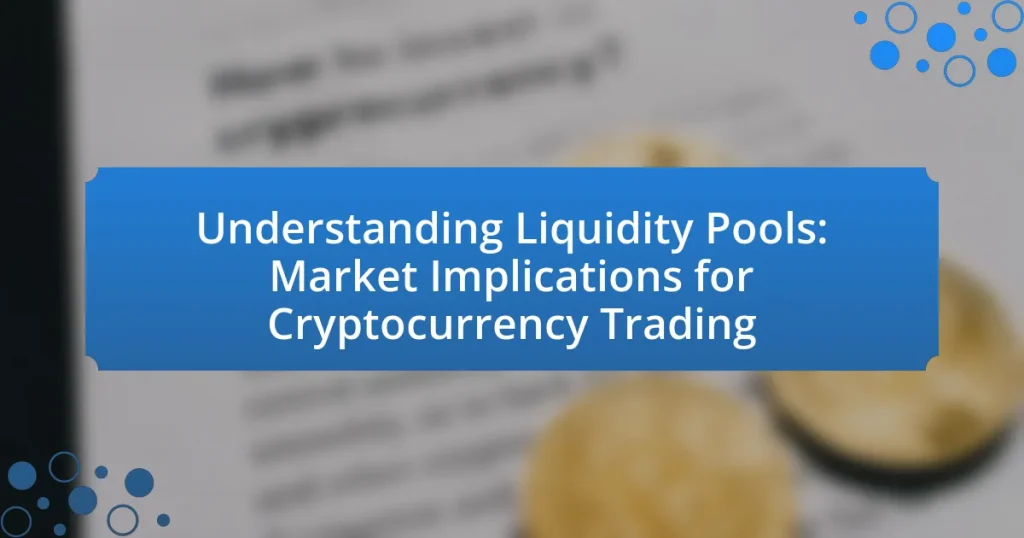Liquidity pools are essential components of cryptocurrency trading, particularly within decentralized exchanges (DEXs). They consist of funds locked in smart contracts that facilitate token swaps without traditional order books, enhancing market efficiency and reducing slippage. This article explores the functionality of liquidity pools, their importance for traders, and their impact on market dynamics, including price stability and volatility. Additionally, it addresses the risks associated with liquidity pools, such as impermanent loss and smart contract vulnerabilities, while providing strategies for traders to effectively utilize these pools and minimize risks. Key metrics for assessing the health of liquidity pools and tools for monitoring them are also discussed, offering a comprehensive understanding of their role in the cryptocurrency market.

What are Liquidity Pools in Cryptocurrency Trading?
Liquidity pools in cryptocurrency trading are collections of funds locked in smart contracts that facilitate trading on decentralized exchanges (DEXs). These pools allow users to trade cryptocurrencies without the need for a traditional order book, as they provide liquidity by enabling users to swap tokens directly from the pool. The liquidity is supplied by users, known as liquidity providers, who deposit their assets into the pool and earn fees from trades that occur within it. According to a report by DeFi Pulse, liquidity pools have significantly increased the efficiency of trading in decentralized finance (DeFi) by reducing slippage and enabling instant transactions.
How do Liquidity Pools function in the market?
Liquidity pools function in the market by allowing users to provide liquidity for trading pairs in decentralized exchanges. These pools aggregate funds from multiple users, enabling traders to swap assets without relying on traditional order books. When users deposit their assets into a liquidity pool, they receive liquidity provider tokens in return, which represent their share of the pool.
The mechanism operates through automated market makers (AMMs), which use algorithms to set prices based on the ratio of assets in the pool. For example, if a pool contains 100 ETH and 10,000 USDT, the price of ETH is determined by the ratio of these assets. This system ensures that trades can occur seamlessly, as liquidity is always available, reducing slippage and improving market efficiency.
Furthermore, liquidity providers earn fees from trades executed within the pool, incentivizing them to maintain their assets in the pool. This model has been validated by the growth of decentralized finance (DeFi), where liquidity pools have become essential for facilitating trading and providing market depth.
What are the key components of a Liquidity Pool?
The key components of a liquidity pool are liquidity providers, smart contracts, and the assets held within the pool. Liquidity providers contribute assets to the pool, enabling trading without the need for a traditional order book. Smart contracts facilitate the automated management of the pool, ensuring that trades are executed according to predefined rules. The assets held within the pool typically include pairs of cryptocurrencies, which are used for trading and generating fees for liquidity providers. These components work together to enhance market efficiency and provide liquidity in decentralized finance platforms.
How do liquidity providers contribute to these pools?
Liquidity providers contribute to liquidity pools by supplying assets that facilitate trading and ensure market efficiency. By depositing cryptocurrencies into these pools, they enable users to execute trades without significant price slippage. This contribution is essential for maintaining liquidity, as it allows for smoother transactions and reduces the risk of large price fluctuations. Furthermore, liquidity providers often earn fees from trades executed within the pool, incentivizing their participation and enhancing overall market stability.
Why are Liquidity Pools important for traders?
Liquidity pools are important for traders because they provide the necessary liquidity for executing trades without significant price slippage. High liquidity in these pools allows traders to buy and sell assets quickly and at stable prices, which is essential for effective trading strategies. For instance, according to a report by the Cambridge Centre for Alternative Finance, liquidity pools facilitate decentralized trading by ensuring that there are always enough assets available for transactions, thus enhancing market efficiency. This accessibility to liquidity directly impacts traders’ ability to enter and exit positions smoothly, ultimately influencing their profitability and risk management.
What advantages do Liquidity Pools offer to traders?
Liquidity pools provide traders with enhanced trading efficiency and reduced slippage. By aggregating funds from multiple participants, liquidity pools ensure that there is sufficient capital available for executing trades at desired prices. This increased liquidity allows traders to enter and exit positions more easily, minimizing the impact of large orders on market prices. Additionally, liquidity pools often offer lower transaction costs compared to traditional exchanges, as they eliminate the need for intermediaries. This combination of improved execution and cost-effectiveness makes liquidity pools a favorable option for traders in the cryptocurrency market.
How do Liquidity Pools impact price stability?
Liquidity pools enhance price stability by providing a consistent source of liquidity for trading assets. When traders can easily buy and sell assets without significant price fluctuations, it reduces volatility. For instance, in decentralized exchanges, liquidity pools allow for automated market-making, which helps maintain balanced buy and sell orders. This mechanism ensures that large trades do not drastically impact the asset’s price, as the liquidity available can absorb the trades. Empirical evidence shows that platforms utilizing liquidity pools, such as Uniswap, experience lower price slippage compared to traditional exchanges, demonstrating their effectiveness in stabilizing prices.

What are the Market Implications of Liquidity Pools?
Liquidity pools significantly impact market dynamics by enhancing trading efficiency and reducing price volatility. They provide a decentralized mechanism for users to trade assets without relying on traditional order books, which can lead to increased market depth and improved price discovery. For instance, the presence of liquidity pools allows for continuous trading, enabling users to execute trades at more stable prices, thereby minimizing slippage. Additionally, liquidity pools can attract more participants to the market, as they often offer incentives such as yield farming rewards, which further increases liquidity and trading volume. This increased participation can lead to a more robust market structure, ultimately benefiting all traders by fostering a more competitive environment.
How do Liquidity Pools influence market volatility?
Liquidity pools influence market volatility by providing a mechanism for traders to execute large transactions without significantly impacting the price of an asset. When liquidity is high in a pool, it allows for smoother trades, reducing the likelihood of sharp price fluctuations. Conversely, low liquidity can lead to increased volatility, as even small trades can cause larger price swings. For example, during periods of low liquidity, a single large sell order can drastically lower the asset’s price, while a large buy order can inflate it. This relationship is supported by empirical studies showing that assets with deeper liquidity pools tend to exhibit lower volatility compared to those with shallower pools.
What role do Liquidity Pools play in price discovery?
Liquidity pools facilitate price discovery by providing a decentralized mechanism for trading assets, which enhances market efficiency. In these pools, users contribute liquidity, allowing for continuous trading without the need for traditional order books. This constant availability of liquidity helps to stabilize prices and reduces volatility, as trades can occur at any time based on supply and demand dynamics. Furthermore, the pricing algorithms used in automated market makers (AMMs) within liquidity pools adjust prices in real-time according to the ratio of assets in the pool, reflecting the market’s valuation of those assets. This mechanism ensures that prices are more responsive to market conditions, thereby improving the accuracy of price discovery in cryptocurrency trading.
How can Liquidity Pools affect trading strategies?
Liquidity pools significantly influence trading strategies by providing essential liquidity for traders, enabling them to execute trades without substantial price slippage. When traders utilize liquidity pools, they can access a larger pool of assets, which facilitates quicker transactions and reduces the impact of large orders on market prices. For instance, decentralized exchanges like Uniswap rely on liquidity pools to allow users to swap tokens efficiently, which directly affects traders’ ability to enter and exit positions swiftly. Additionally, the presence of liquidity pools can lead to more competitive pricing, as arbitrage opportunities arise when price discrepancies exist across different platforms. This dynamic encourages traders to develop strategies that capitalize on these price variations, ultimately enhancing market efficiency.
What risks are associated with Liquidity Pools?
Liquidity pools carry several risks, including impermanent loss, smart contract vulnerabilities, and market volatility. Impermanent loss occurs when the value of assets in the pool diverges from their value outside the pool, leading to potential losses for liquidity providers. Smart contract vulnerabilities can expose liquidity pools to hacks or exploits, as seen in incidents where poorly audited contracts were compromised. Additionally, market volatility can lead to rapid price changes, affecting the liquidity and stability of the pool. These risks highlight the importance of thorough research and risk management for participants in liquidity pools.
How can impermanent loss impact liquidity providers?
Impermanent loss can significantly impact liquidity providers by reducing the overall returns on their investments in liquidity pools. When the price of the assets in a liquidity pool diverges from their initial value, liquidity providers may experience a decrease in the value of their holdings compared to simply holding the assets outside the pool. For instance, if a liquidity provider deposits equal values of two cryptocurrencies and one appreciates significantly, the provider will end up with less of the appreciating asset when they withdraw, leading to a loss that is termed “impermanent.” Research indicates that impermanent loss can be substantial, with estimates suggesting that it can reach up to 50% or more in volatile markets, thereby affecting the profitability and attractiveness of providing liquidity.
What are the security concerns related to Liquidity Pools?
Liquidity pools face several security concerns, primarily including smart contract vulnerabilities, impermanent loss, and potential for malicious attacks. Smart contract vulnerabilities arise from coding errors or exploits that can lead to loss of funds; for instance, the 2020 hack of the Harvest Finance protocol resulted in a loss of $24 million due to such vulnerabilities. Impermanent loss occurs when the value of assets in a liquidity pool fluctuates, leading to reduced returns for liquidity providers compared to holding the assets directly. Additionally, liquidity pools are susceptible to malicious attacks, such as flash loan attacks, where attackers exploit the liquidity pool’s mechanics to manipulate prices and drain funds. These concerns highlight the importance of robust security measures and audits in the management of liquidity pools.

How can Traders Effectively Utilize Liquidity Pools?
Traders can effectively utilize liquidity pools by providing liquidity to earn fees and participating in yield farming. By depositing assets into liquidity pools, traders contribute to the overall liquidity of decentralized exchanges, which allows for smoother transactions and better price stability. In return, they receive a portion of the trading fees generated by the pool, which can be a significant source of passive income. Additionally, yield farming enables traders to maximize returns by staking their liquidity provider tokens in various protocols, often leading to higher rewards. According to a report by DeFi Pulse, liquidity providers can earn annual percentage yields (APYs) ranging from 10% to over 100%, depending on the pool and market conditions. This demonstrates the potential profitability of effectively utilizing liquidity pools in cryptocurrency trading.
What strategies can traders employ when using Liquidity Pools?
Traders can employ several strategies when using liquidity pools, including arbitrage, yield farming, and liquidity provision. Arbitrage involves taking advantage of price discrepancies across different exchanges or liquidity pools to generate profit. For instance, if a token is priced lower in one pool compared to another, traders can buy low and sell high, capitalizing on the difference.
Yield farming allows traders to earn rewards by providing liquidity to a pool, often receiving tokens or fees in return. This strategy can be particularly lucrative in decentralized finance (DeFi) platforms where high yields are offered for liquidity providers.
Liquidity provision involves depositing assets into a liquidity pool to facilitate trading, earning a share of the transaction fees generated by the pool. This strategy is beneficial when the trading volume is high, as it can lead to significant passive income.
These strategies are validated by the growing adoption of DeFi protocols, which have seen billions in total value locked, indicating the effectiveness and popularity of liquidity pools among traders.
How can traders assess the health of a Liquidity Pool?
Traders can assess the health of a liquidity pool by analyzing key metrics such as total value locked (TVL), trading volume, and the pool’s impermanent loss. Total value locked indicates the amount of assets within the pool, reflecting its size and stability; a higher TVL generally suggests a healthier pool. Trading volume provides insight into the pool’s activity level, with higher volumes indicating robust trading interest and liquidity. Additionally, understanding impermanent loss helps traders evaluate potential risks associated with price fluctuations of the assets in the pool. These metrics collectively offer a comprehensive view of the liquidity pool’s overall health and viability for trading.
What tools are available for monitoring Liquidity Pools?
Tools available for monitoring Liquidity Pools include Dune Analytics, DeFi Pulse, and Zapper. Dune Analytics allows users to create custom queries and dashboards to visualize on-chain data, providing insights into liquidity pool performance. DeFi Pulse tracks the total value locked in various DeFi protocols, offering a snapshot of liquidity across multiple platforms. Zapper aggregates DeFi assets and provides a user-friendly interface to manage and monitor liquidity positions, enabling users to see their investments in real-time. These tools are widely used in the cryptocurrency trading community for effective liquidity management and analysis.
What best practices should traders follow when engaging with Liquidity Pools?
Traders should prioritize risk management, research, and diversification when engaging with liquidity pools. Effective risk management involves assessing potential impermanent loss and setting limits on investment amounts to mitigate losses. Researching the specific liquidity pool, including its tokenomics and historical performance, helps traders make informed decisions. Diversification across multiple liquidity pools reduces exposure to any single asset’s volatility, enhancing overall portfolio stability. These practices are essential as they help traders navigate the complexities of liquidity pools and optimize their trading strategies.
How can traders minimize risks while participating in Liquidity Pools?
Traders can minimize risks while participating in liquidity pools by diversifying their investments across multiple pools and assets. Diversification reduces exposure to any single asset’s volatility, thereby lowering the potential for significant losses. Additionally, traders should conduct thorough research on the liquidity pool’s underlying assets, assessing their historical performance and market trends to make informed decisions. Implementing strategies such as setting stop-loss orders can further protect against sudden market downturns. According to a study by the Cambridge Centre for Alternative Finance, diversified portfolios tend to yield more stable returns, reinforcing the importance of risk management in liquidity pool participation.
What common mistakes should traders avoid with Liquidity Pools?
Traders should avoid several common mistakes when engaging with liquidity pools, including inadequate research, ignoring impermanent loss, and failing to monitor pool performance. Inadequate research can lead to poor decisions regarding which pools to enter, as traders may overlook critical factors such as token volatility and pool liquidity. Ignoring impermanent loss, which occurs when the value of tokens in a liquidity pool diverges significantly from their original value, can result in substantial financial losses. Additionally, failing to monitor pool performance can prevent traders from reacting to market changes, leading to missed opportunities or increased risks. These mistakes can significantly impact a trader’s profitability and overall success in the cryptocurrency market.


